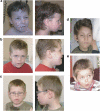Structural variation in Xq28: MECP2 duplications in 1% of patients with unexplained XLMR and in 2% of male patients with severe encephalopathy
- PMID: 18985075
- PMCID: PMC2986218
- DOI: 10.1038/ejhg.2008.208
Structural variation in Xq28: MECP2 duplications in 1% of patients with unexplained XLMR and in 2% of male patients with severe encephalopathy
Erratum in
- Eur J Hum Genet. 2009 May;17(5):697
Abstract
Duplications in Xq28 involving MECP2 have been described in patients with severe mental retardation, infantile hypotonia, progressive spasticity, and recurrent infections. However, it is not yet clear to what extent these and accompanying symptoms may vary. In addition, the frequency of Xq28 duplications including MECP2 has yet to be determined in patients with unexplained X-linked mental retardation and (fe)males with severe encephalopathy. In this study, we used multiplex ligation-dependent probe amplification to screen Xq28 including MECP2 for deletions and duplications in these patient cohorts. In the group of 283 patients with X-linked mental retardation, we identified three Xq28 duplications including MECP2, which suggests that approximately 1% of unexplained X-linked mental retardation may be caused by MECP2 duplications. In addition, we found three additional MECP2 duplications in 134 male patients with mental retardation and severe, mostly progressive, neurological symptoms, indicating that the mutation frequency could be as high as 2% in this group of patients. In 329 female patients, no Xq28 duplications were detected. In total, we assessed 13 male patients with a MECP2 duplication from six unrelated families. Moderate to severe mental retardation and childhood hypotonia was noted in all patients. The majority of the patients also presented with absent speech, seizures, and progressive spasticity as well as ataxia or an ataxic gait and cerebral atrophy, two previously unreported symptoms. We propose to implement DNA copy number testing for MECP2 in the current diagnostic testing in all males with moderate to severe mental retardation accompanied by (progressive) neurological symptoms.
Figures


References
-
- Ariani F, Mari F, Pescucci C, et al. Real-time quantitative PCR as a routine method for screening large rearrangements in Rett syndrome: Report of one case of MECP2 deletion and one case of MECP2 duplication. Hum Mutat. 2004;24:172–177. - PubMed
-
- del Gaudio D, Fang P, Scaglia F, et al. Increased MECP2 gene copy number as the result of genomic duplication in neurodevelopmentally delayed males. Genet Med. 2006;8:784–792. - PubMed
-
- Friez MJ, Jones JR, Clarkson K, et al. Recurrent infections, hypotonia, and mental retardation caused by duplication of MECP2 and adjacent region in Xq28. Pediatrics. 2006;118:e1687–e1695. - PubMed
MeSH terms
Substances
LinkOut - more resources
Full Text Sources
Medical

